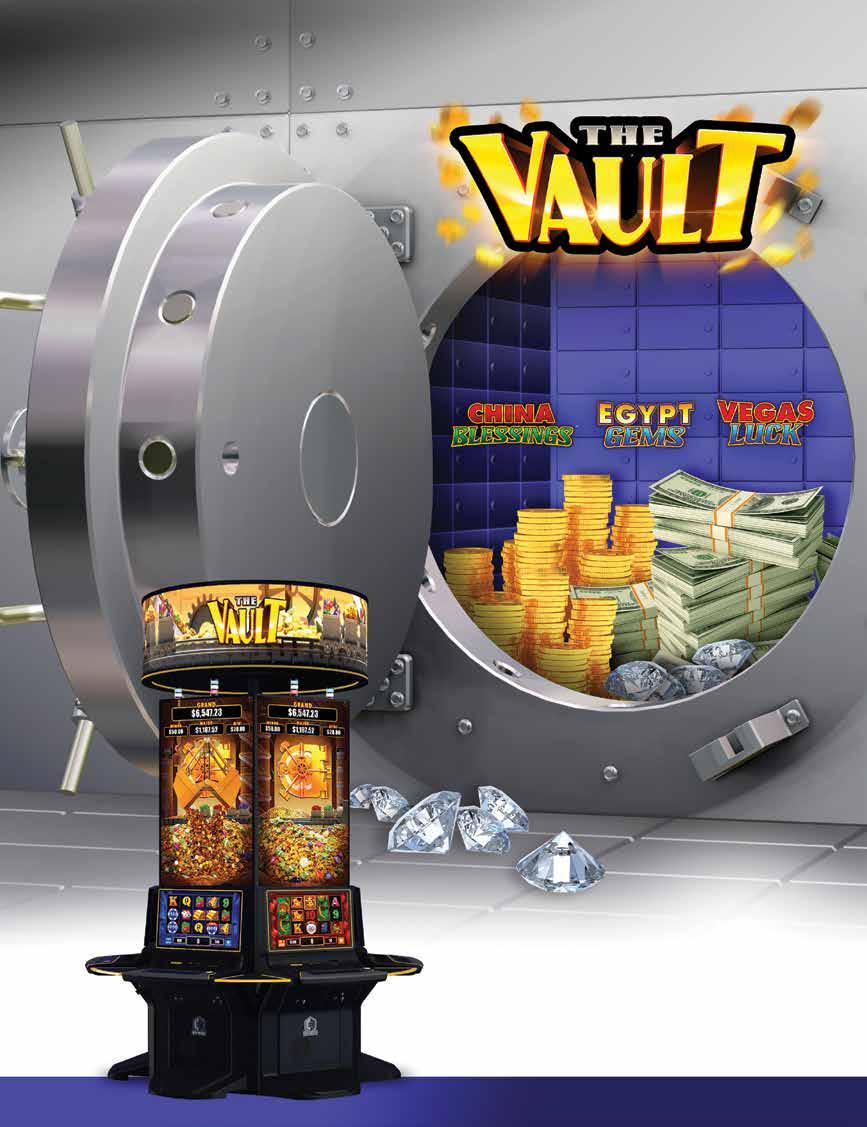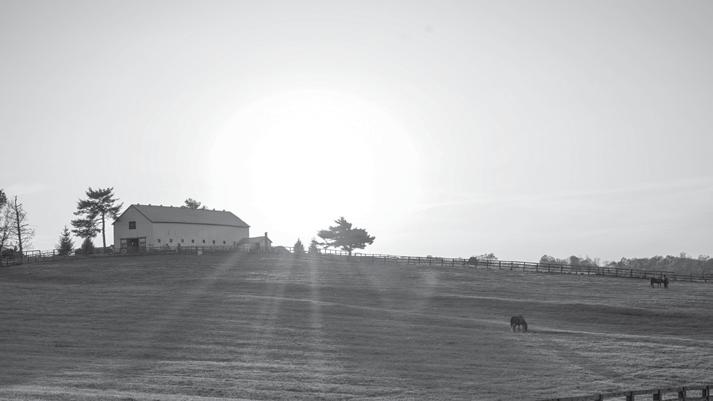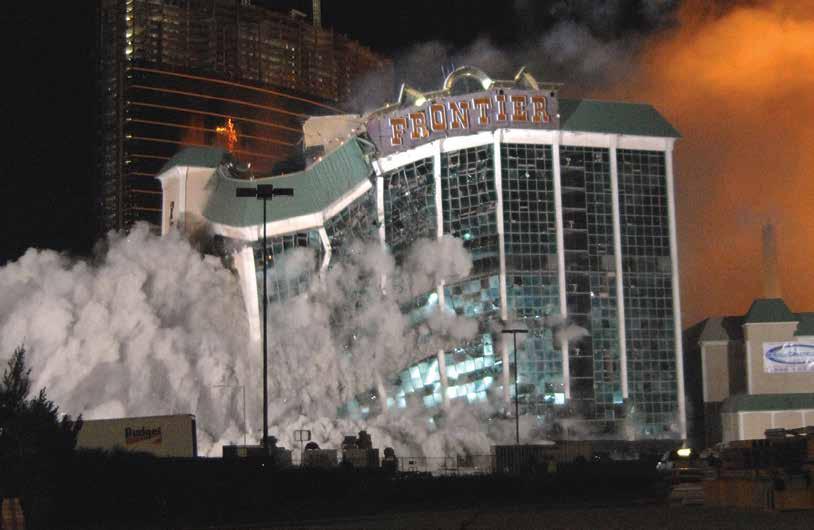
8 minute read
Las Vegas Implosions
New Frontier - D-Day: November 13, 2007
TOP LAS VEGAS IMPLOSIONS
DEMOLITION IN THE DESERT
by MARK COOMES
In this article, we highlight some of the most memorable implosions in Las Vegas history. Originally published in 2007, we felt this was a timeless feature that really never gets old. We hope you enjoy it!
“What goes up, must come down” is the most mundane law in the physical universe, a reality as unremarkable as the sight of a ripe apple falling from a tree. Leave it to Las Vegas to turn gravity into glitz – and put Wayne Newton and Isaac Newton on the same marquee. This is what happens when physics and civics collide: 20,000 people turn out to watch a 15-story casino collapse in less time than it takes to play a hand of blackjack. Now that’s a party.
In Sin City, the greatest transgression is not debauchery, drunkenness or losing Junior’s college fund to a one-armed bandit. It is missing the opportunity to turn an event into a spectacle – and nothing is more spectacular than watching a House of Cards fall like a house of cards. Vegas has seen an explosion of implosions in recent years. But with two exceptions, every end was a new beginning. A bigger, badder, flashier playpen rose like a phoenix to take its place.
The Dunes was reborn as The Bellagio. The Hacienda became Mandalay Bay. The New Frontier, razed last fall, will beget a yet-to-be-named super resort in 2011 – at a cost of $8 billion. Bugsy Siegel, the mobster who practically invented Las Vegas, spent $7.994 billion less to open The Flamingo in 1946. You have to wonder which would amaze him more: How much construction prices have risen, or how fast these casinos can fall?
it takes about five seconds to collapse a 16-story edifice like the New Frontier. Explosive charges are strategically placed in a building’s infrastructure and detonated in quick succession. Concrete shatters; steel beams splinter. The building is dropped in its own tracks. It takes more than five seconds for every chunk and pebble to fall, of course, but the end is swift and inevitable. Sir Isaac Newton would delight in how deftly the demolition experts apply the gravitational laws he discovered five centuries ago. Once those first few charges explode, there is nowhere to go but down.
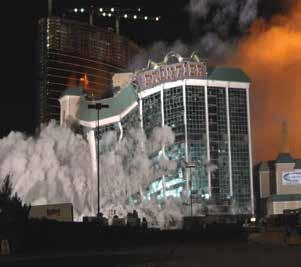
Let’s take a tour of the destruction starting with the most recent.
NEW FRONTIER D-DAY: NOVEMBER 13, 2007
The New Frontier is most famous for its “firsts” and “lasts.” In 1956, it played host to Elvis Presley’s Vegas debut. In 1970, it staged the final performance of Diana Ross and The Supremes. It also launched the careers of Siegfried & Roy. Not bad for a place that opened in 1942 as a little nightclub called Pair-O-Dice. Talk about a winning roll. The New Frontier even had the chops to survive one of the longest labor strikes in U.S. history – a six-year, four-month ordeal that spanned the deaths-by-implosion of four major resorts, including The Dunes and The Sands.
STARDUST RESORT & CASINO D-DAY: MARCH 13, 2007
When The Stardust opened in 1958, it boasted the biggest hotel, the biggest casino and the biggest swimming pool in Nevada. It also had a penchant for getting into big trouble. In 1961, its management team included a former crony of Al Capone and a career criminal with 14 convictions for everything from assault to tax evasion. In ’84, the Stardust was fined $3 million for skimming. New, squeaky-clean owners took over in ’85, updated the resort’s iconic sign and added a 32-story tower in 1991. Fifteen years later, the tower came down in a cloud of dust, gaining the dubious distinction of being the newest high-rise ever to meet such a fate.
BOARDWALK HOTEL AND CASINO
D-DAY: MAY 9, 2006
Small and unremarkable, save for the wooden roller coaster outside, the Boardwalk was a prize property for three reasons: Location, location, location. Lodged between the Bellagio and Monte Carlo – and across the Strip from the Paris, Aladdin and MGM Grand – the Boardwalk was begging to be razed and resurrected. If for no other reason than to get rid of it’s famously awful, 24-hour Surf Buffet.

DESERT INN D-DAY: OCTOBER 23, 2001
For nearly 50 years, everybody who was anybody wanted to play the Desert Inn’s famous “crystal showroom.” A very partial list of marquee names includes Cher, Sinatra, Liberace, Tina Turner, Barry Manilow, Don Rickles, Bob Newhart, Rich Little and Roseanne Barr. Howard Hughes liked “The D.I.” so much that he bought it. So did Steve Wynn, who demolished it. The decision puzzled many locals. Unlike other old-school casinos, The D.I. was in good shape, fiscally and physically. The new palace, Wynn Las Vegas, is hardly an eyesore, but the Desert Inn was arguably Sin City’s most cinematic resort. It was the backdrop for the original “Ocean’s Eleven,” the TV series “Vega$” and the blockbuster action flick “Rush Hour 2.”
EL RANCHO D-DAY: OCTOBER 3, 2000
The El Rancho’s history is confusing and mercifully brief. Born as the Thunderbird in 1948, it was renamed in 1982 after the first hotel ever erected on the Strip, El Rancho Vegas. The original resort burned down in 1960 in a blaze that began as Betty Grable was doing a late show on the main stage. That perch was previously occupied by legendary stripper Candy Barr, who was carted off by the FBI after
the U.S. Supreme Court upheld her Texas marijuana conviction in 1959. The new El Rancho went kaput in 1992. Eight years later, it was imploded by the owners of a high-rise condo project next door – simply to provide their residents a nicer view.

THE ALADDIN D-DAY: APRIL 27, 1998
The Aladdin opened in 1966 by ditching its original Olde English motif and bringing an air of Arabia to the Nevada desert instead. In a grand gesture of Bedouin bling, owner Milton Prell spent $750,000 on a bulb-encrusted version of Aladdin’s lamp that stood 15 stories high. The Aladdin hosted the nuptials of Elvis and Priscilla Presley in 1967, a windfall for Neil Diamond (who earned $750,000 for playing only two shows) in ’76 and a brief foray into casino ownership for Wayne Newton (who bought and sold between ’80 and’82). The shine faded from Aladdin’s lamp in the early 1990s. The place was demolished in ’97 but reopened in 2000. Dogged by a culinary workers strike, the new Aladdin struggled for three years and was then sold to the Planet Hollywood folks.
THE HACIENDA D-DAY: DEC. 31, 1996/ JAN. 1, 1997
The Hacienda’s last gasp was a New Year’s Eve party that truly brought down the house.
A few hours after Dick Clark dropped the ball in Times Square, a demolition crew brought down the resort that in the 1950s was a virtual “Welcome to Las Vegas” sign for West Coast tourists.
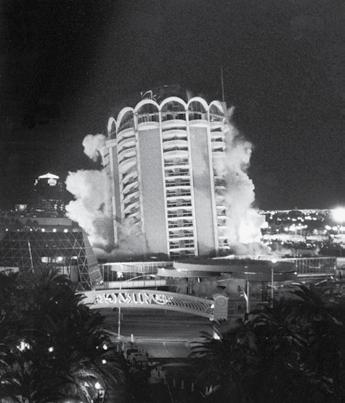
Standing all alone on the south end of the Strip, The Hacienda was first place seen by vacationers driving in from California. It was not, however, a hotspot for stars. Mass marketing was The Hacienda’s claim to fame. Owner Doc Bayley formed his own airline to fly in gamblers from around the world. He catered to low-rollers, too, with inexpensive junkets for retirees from the Midwest. The low-budget ethos seemingly stuck with The Hacienda to the bitter end. The building didn’t collapse into its own footprint, as a good implosion should, but toppled into the parking lot instead. An old-fashioned wrecking crew had to complete the demolition.
THE SANDS D-DAY: NOVEMBER 26, 1996
At its peak in the Eisenhower Era, no place on the Strip was as hip as The Sands. The Rat Pack was born there. Judy Garland, Lena Horne and Bobby Darrin performed there. But contrary to popular belief, the original “Ocean’s Eleven” was not filmed there. The Sands reached the pinnacle of cool in 1960, when Frank Sinatra, Dean Martin, Sammy Davis Jr., Joey Bishop and Peter Lawford staged a show in the Copa Room that ran for three weeks. Sinatra, Davis, Nat King Cole and Count Basie all recorded live records at The Sands. Even in the early ‘90s, when The Sands was being eclipsed by the new megaresorts, Diana Ross and Liza Minnelli still considered it a privilege to play the legendary Copa. The fond memories live on. Collectors pay up to $30 for a single $1 chip from The Sands. Rarer chips can fetch more than $1,000.
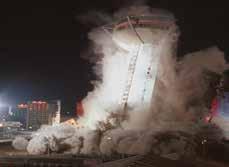
THE LANDMARK D-DAY: NOVEMBER 7, 1995
That’s right: They razed paradise and put up a parking lot. Then again, in light of its troubled past, The Landmark was probably more pit than paradise anyway. The hotel’s original developer went broke in 1962, and its 31-story tower – the biggest skyscraper in Nevada at the time – stood unfinished and unoccupied for seven years. Eccentric billionaire Howard Hughes finally opened the joint in 1969 but lost interest in the project within a year. The Landmark was beset by a near-Biblical string of plagues starting in 1977, when a carbon monoxide leak killed one guest and injured 138 others. A massive power outage was followed by a flooded basement. The Landmark closed in 1990 but sat empty for another three years. One hundred pounds of explosives finally felled the tower in 17 seconds flat.

